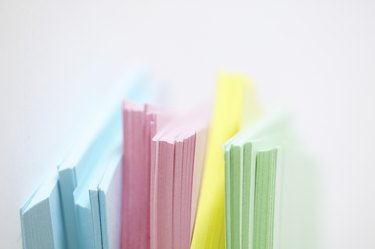Things You'll Need
Medium-grit sandpaper
Paintbrush
Damp rag (optional)
Paintbrush
Ruler (optional)
Boning tool (optional)
Brayer tool (optional)

In 1967, the craft world was introduced to a fast-drying multiuse product known as Mod Podge. Most commonly used for decoupaging craft projects, it's a glue, sealant and finishing product in one bottle. Since the first release, the Mod Podge line has grown to include specialty finishes such as matte, gloss and holographic. Whatever the type of Mod Podge you reach for, if you do not know the proper application technique for attaching paper to wood, your finished product may end up with bubbles.
Step 1
Sand the wood surface with medium-grit sandpaper. Pass over the entire surface two to three times. The rougher surface makes it easier to adhere the paper to the wood. Dust the surface of the wood using a dry paintbrush or damp rag, to remove any dust created from sanding.
Video of the Day
Step 2
Dip a dry paintbrush in the Mod Podge. Brush the surface of the wood with the brush to create a thin coating. Put more Mod Podge on your brush, as necessary.
Step 3
Paint a thin layer of Mod Podge onto the back of your paper. Start at the center of the paper, and work your way out so the edges are the last to receive the glue.
Step 4
Check the surface of the wood by touching it lightly with your fingertip. If the surface is dry to the touch, place the paper onto the wood surface. If not, let it dry another two to three minutes and retest.
Step 5
Smooth the surface of the paper for the next two to three minutes, while the wood's surface and paper's back adhere to one another. Use your fingers, the edge of a ruler or a boning tool. For larger flat surfaces, use a brayer tool and roll the surface of the paper. Start at the center of the project, and smooth your way toward the edges as you work the bubbles away from the center.
Step 6
Let the glue dry another three to four hours. Apply a second thin layer of Mod Podge to the surface of the project, using a paintbrush. Let it dry for three to four hours. Apply a third layer of Mod Podge in the same manner, to seal the project. Allow it to dry overnight.
Tip
Spray a clear acrylic sealant on the project once it's complete, to create a stronger seal and cut down on tackiness from the Mod Podge.
Video of the Day